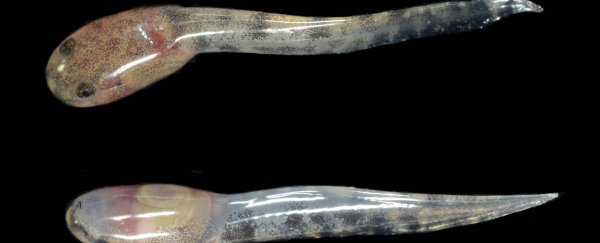When it comes to reproduction, frogs generally fall into two categories - most species lay eggs, while a very small group give birth to live froglets.
But in a world-first, scientists have now discovered a species of fanged frog that gives birth to live tadpoles.
The species, Limnonectes larvaepartus, was discovered in Sulawesi Island in Indonesia by zoologists from the University of California, Berkeley, in the US, and it's now been described in PLOS ONE.
Overwhelmingly, most of the world's frog species reproduce via external fertilisation. There is a small group that have evolved internal fertilisation, which means they either lay already fertilised eggs, or occasionally give birth to baby froglets. But this new fanged frog is doing something else entirely.
"Almost all frogs in the world - more than 6,000 species - have external fertilisation, where the male grips the female in amplexus and releases sperm as the eggs are released by the female," lead author Jim McGuire said in a press release.
"This new frog is one of only 10 or 12 species that has evolved internal fertilisation, and of those, it is the only one that gives birth to tadpoles, as opposed to froglets or laying fertilised eggs."
The scientists still aren't sure exactly how the male would fertilise the female's eggs - frogs don't have sex organs that they can use to transfer sperm. To overcome this, some species that use internal fertilisation have evolved a penis-like "tail" that does this, but this new species doesn't seem to have any unusual structures at all.
The species was first noticed in the '90s, but it was thought they were just a subspecies of an existing species of fanged frog, which belong to the genus Limnonectes. Their fangs aren't actually teeth at all, but two fleshy lumps on their bottom lip which they use in fighting against each other for mates.
However, after studying these frogs in more detail, it became apparent that they had a completely unique reproductive strategy, and were a distinct species.
It's believed there are 25 species of fanged frogs living on Sulawesi, but so far only four of them have been described. Unfortunately the island has one of the highest deforestation rates in the world, so the race is now on to find out more about the remaining species.
"Finding a new species is not that rare - but actually discovering a new reproductive mode is," Ben Tapley from the Zoological Society of London, told the BBC.
"There are more than 40 of these modes in amphibians, but this one is obviously totally unique… These kind of findings are really valuable, especially in Sulawesi where most of the forest is gone."
Source: BBC
